Smart homes are a network of intelligent systems and devices designed to automate and improve homes. The term “smart” has become associated with any technology that incorporates Artificial Intelligence (AI) in recent years. Incorporating smart technology into homes can improve comfort, healthcare, security, and energy conservation. This has led to the acceptance of Smart Home Systems (SHS) as a popular concept.
Smart technology extends beyond homes to include smart cities, smart manufacturing, and more. However, Smart Home Systems are a specific branch of smart computing that focuses on integrating AI technologies into homes to enhance the quality of life.
This article delves into the integration of AI in smart homes, exploring how various AI fields are incorporated into smart home devices and systems. It examines how these integrations function and delves into frameworks, libraries, and applications.
Let’s dive in.
About us: viso.ai offers Viso Suite, the world’s only comprehensive Computer Vision Platform. This technology enables organizations worldwide to develop, deploy, and scale all computer vision applications in one place. Request a demo.
Understanding AI in Smart Homes
Smart homes have undergone significant evolution over the years, with AI being a central component of their operations. AI plays a crucial role in enabling the intelligence and automation that define a truly “smart” home. Even early smart home technologies incorporated basic AI logic. To gain a deeper understanding of smart home technologies, it’s essential to first grasp the concept of AI and then explore how it can be integrated into smart homes.
What is AI?
Artificial intelligence (AI) is a technology that enables machines to learn and mimic human intelligence. When combined with other technologies, AI can perform a wide range of tasks, as seen in smart homes. AI is a broad term that encompasses any machine that simulates human intelligence.
AI comprises two sub-disciplines: machine learning and deep learning (where deep learning is a sub-discipline of machine learning).
Both Machine Learning (ML) and Deep Learning (DL) utilize Artificial Neural Networks. These neural networks are modeled by researchers based on the decision-making process of the brain. Neural networks consist of interconnected nodes across multiple layers. ML and deep learning differ in the types of neural networks they use.
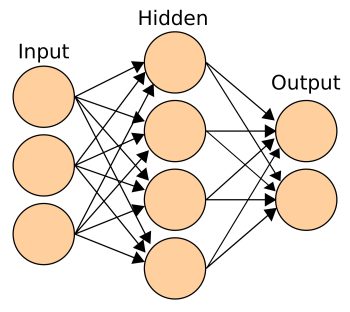
These neural networks require vast amounts of data to make accurate predictions and classifications. Artificial Neural Networks learn from these datasets through various methods:
- Supervised learning: Researchers use labeled datasets to train the model through cross-validation, enabling accurate data classification and outcome prediction.
- Unsupervised learning: Researchers utilize unlabeled datasets to analyze and cluster data. This method allows the algorithm to identify similarities and differences in the data, making it suitable for various tasks.
- Reinforcement Learning: Popular in robotics, this method involves the algorithm learning through a reward-punishment mechanism. This trial-and-error approach enables the machine to take actions that bring it closer to its goal.
Let’s delve into how AI is integrated into smart homes.
How AI is Integrated into Smart Homes?
AI serves as the core of smart home systems. The advancement of AI enables homes to become more intelligent by making devices proactive. Smart homes utilize a variety of devices to automate and enhance living conditions, particularly for individuals with disabilities or seniors. For instance, visually impaired individuals can utilize home cameras and voice commands to simplify their daily lives.
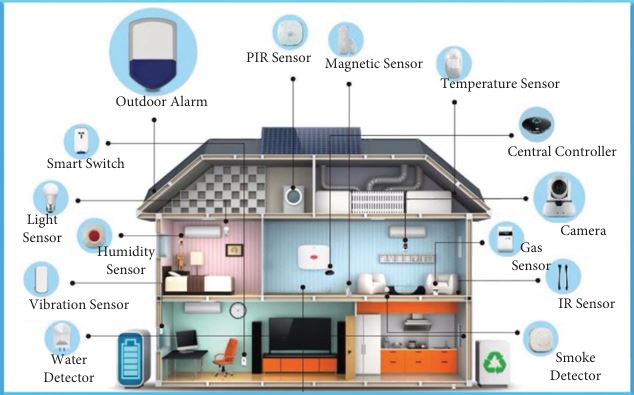

Interactions between the user, AI, and devices generally fall into two main models:
- Case A: Users can issue commands directly to devices, allowing the AI within each device to enhance its functionality. This is typically achieved through edge computing technologies and is ideal for applications like healthcare, security, and energy management.
- Case B: Users can issue commands to an AI via their phone or central controller using voice assistants like Alexa or Google Assistant. The AI then controls each device accordingly, often utilizing cloud computing technologies. This setup is beneficial for smart interactions and device management.
Smart devices such as sensors, cameras, and appliances are interconnected through the Internet of Things (IoT). These devices continuously gather data such as temperature, energy consumption, motion detection, voice commands, and more. With this information, AI can make decisions, predictions, and automate tasks.
In edge computing, AI models are embedded directly into devices, enabling them to process data without relying on a cloud server. This approach reduces latency and enhances privacy, although it may limit performance based on computational resources. On the other hand, cloud computing utilizes powerful servers to handle data processing.
Smart homes typically adopt a hybrid approach to interaction and computing models, leveraging multiple AI models as the intelligence behind the scenes. In the following section, we’ll explore the key AI models used in smart home settings.
Key AI Technologies in Smart Homes
Smart homes leverage a diverse array of AI models to carry out various tasks that enhance home functionality, user comfort, and energy efficiency. Engineers integrate fields such as Computer Vision (CV), Large Language Models (LLMs), Reinforcement Learning (RL), and more within smart home environments. Let’s delve into these fields and how they are integrated into the smart home ecosystem.
Computer Vision (CV)
Computer Vision technologies, such as cameras and motion sensors, are utilized in smart homes for tasks like remote control, appliance monitoring, and home security systems. These technologies employ machine learning algorithms to analyze and make predictions based on image and video data, even in real-time.
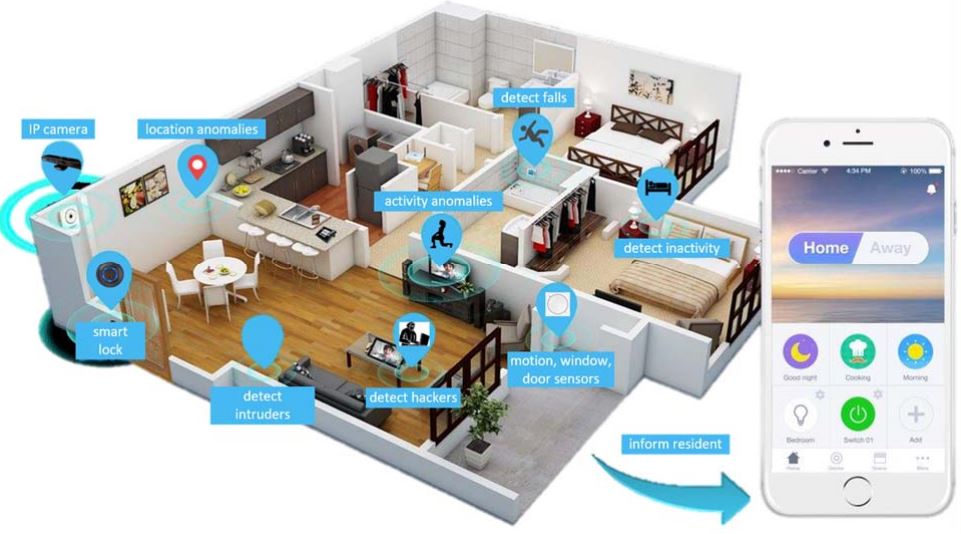

AI models in smart devices can be used for tasks such as object detection, recognition, and segmentation. Models and frameworks like YOLOv10 and OpenCV can be tuned for real-time detection tasks such as theft prevention, fall detection, activity monitoring, and more. Computer vision models rely on deep learning techniques and various types of Neural Networks, such as Convolutional Neural Networks (CNNs) or Recurrent Neural Networks (RNNs), for video processing in smart home applications. Here are some examples of devices that can benefit from these computer vision models:
- A smart lock installed on the front door with a video doorbell can prevent, detect, and report intruders.
- In-home cameras can be used for tasks like fall detection, activity monitoring, and energy-efficient operations by detecting movement to control lighting, TVs, or other smart home devices. These models can also assist in inventory management for appliances like refrigerators, identifying missing or expired groceries.
These are just a few use cases of computer vision technology in smart homes. However, computer vision alone is not sufficient to make a home smart. Let’s explore some other AI technologies that engineers use in smart home devices.
Natural Language Processing (NLP)
NLP is an AI field that enables computers to recognize, understand, and generate text and speech. Recent advancements in NLP have led to the development of powerful Large Language Models (LLMs) through generative AI. These models, such as GPT-4, Alexa, and other voice assistants, play a vital role in home automation.
In a smart home setting, LLMs are crucial for automation. In a smart home, an LLM can function as a Large Action Model (LAM), capable of understanding, generating text and speech, and taking actions based on inputs. Inputs can come from users’ voice commands, collected data, or home settings.
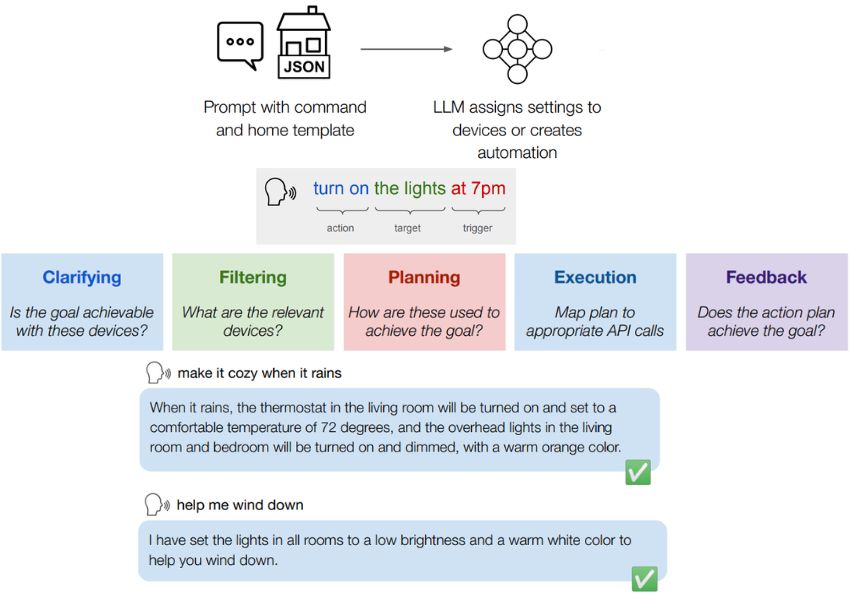

When combined with other smart devices and AI models, LLMs can perform a variety of tasks for home automation. LLMs can act as triggers for actions or responses, enabling voice control of devices like smart lighting or door locks. They can provide feedback from devices such as smart thermostats for temperature readings or smart plugs for energy consumption levels.
Devices like Amazon Echo (Alexa) can be integrated with smart devices through apps and Wi-Fi connections. The model can also be embedded within the house itself, allowing users to interact with it through speakers located throughout the home.
If we want models in our homes to learn and evolve over time or incorporate robotics, reinforcement learning is a valuable tool. In the next section, we’ll explore reinforcement learning and its applications in smart homes.
Reinforcement Learning (RL)
Reinforcement learning in smart homes can optimize efficiency, automation, and comfort by incorporating human feedback and activity data. This is particularly beneficial for tasks like energy management or home robotics. For energy-efficient smart homes, engineers are focusing on intelligent Home Energy Management Systems (HEMS). These systems typically require components like advanced metering infrastructure with smart meters and RL systems to learn patterns and optimize energy consumption.
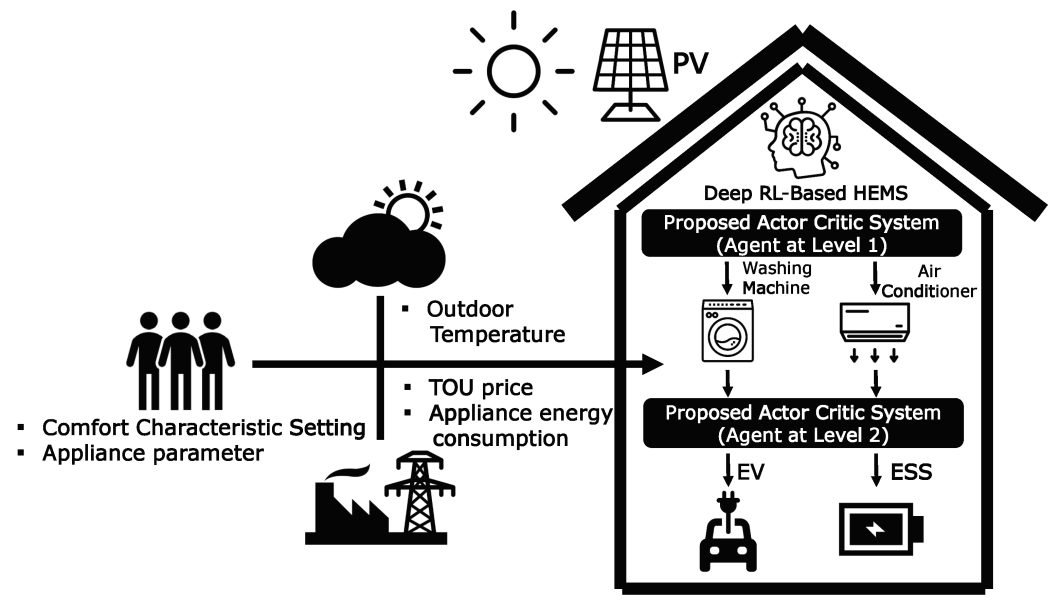

RL-based HEMS in smart homes utilize home devices and energy sources to optimize energy consumption. These systems employ



